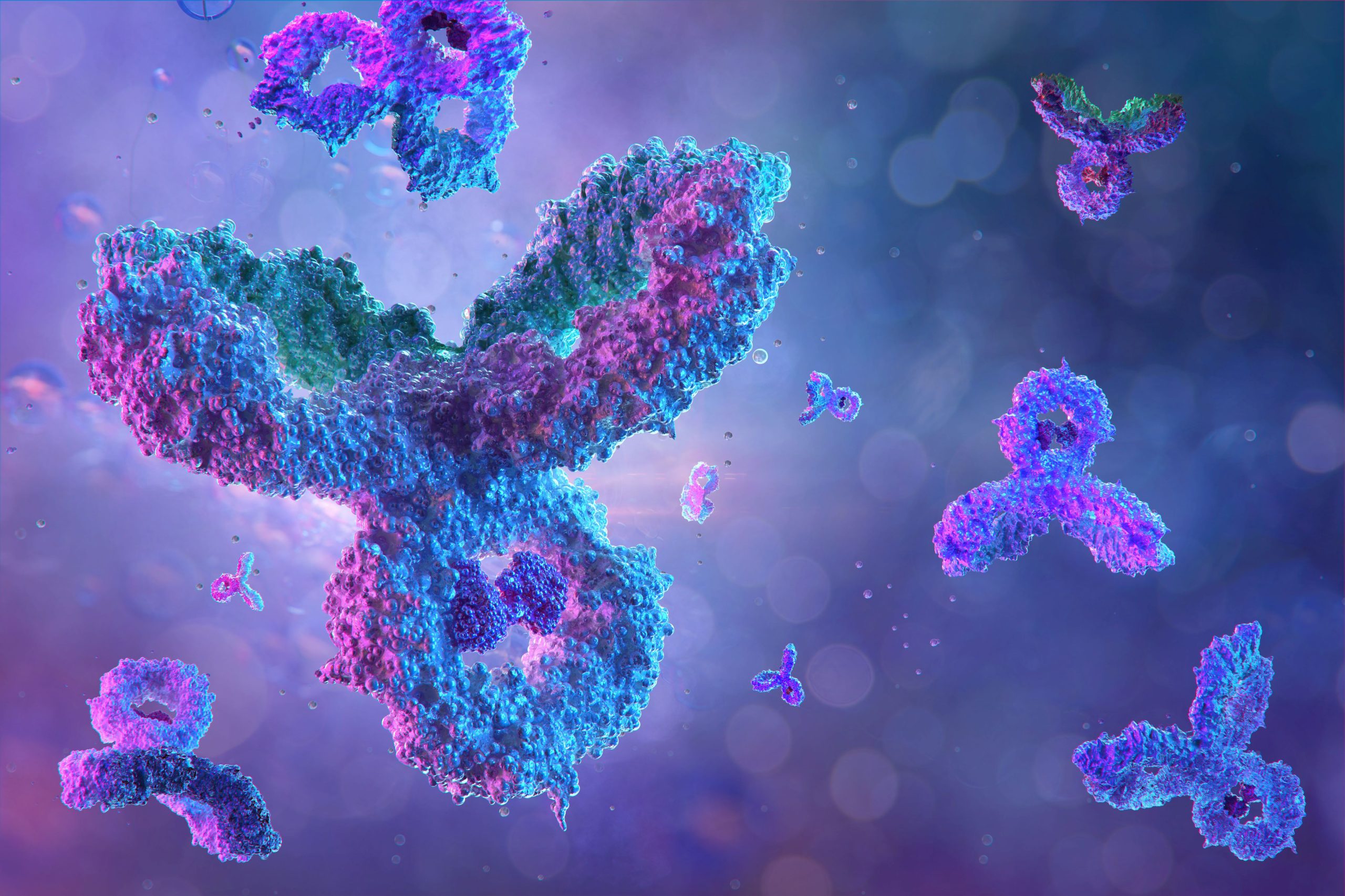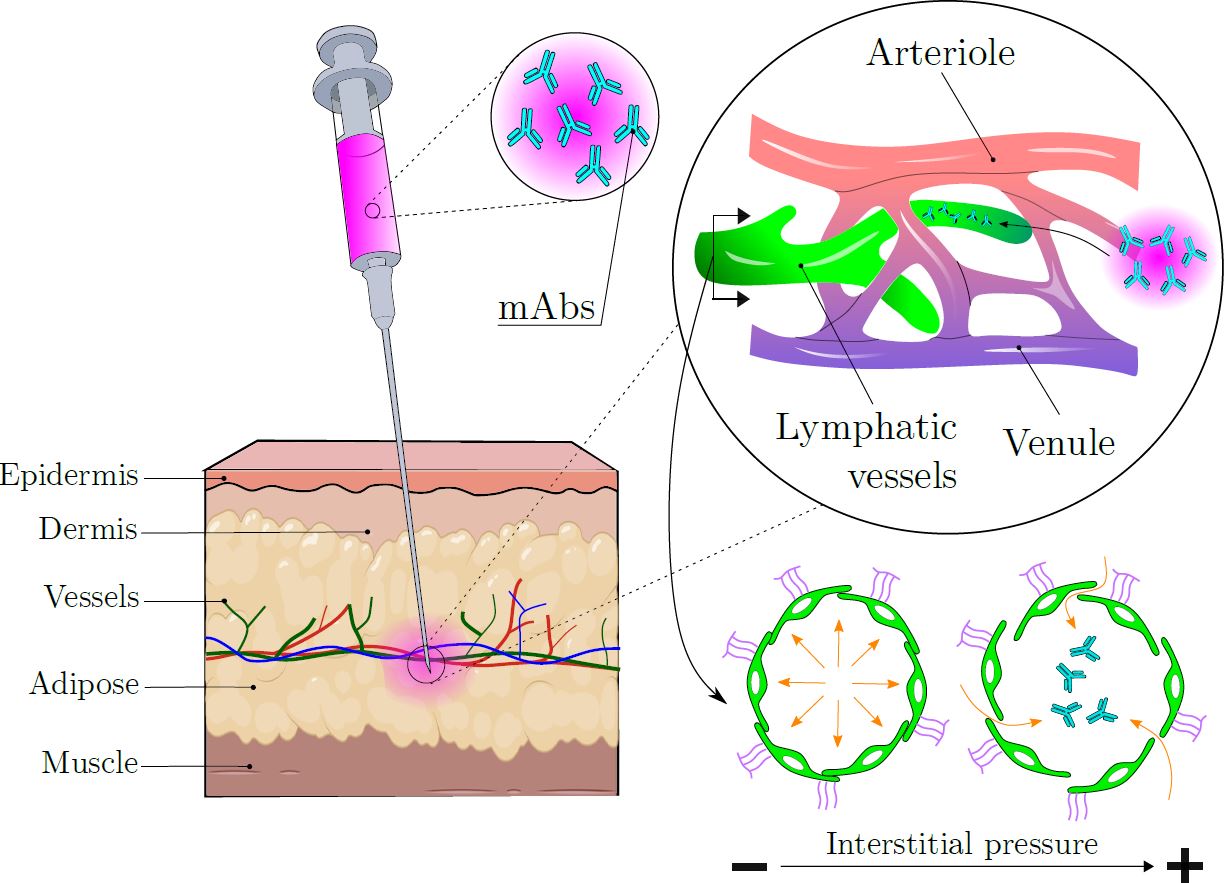
Understanding the movement of monoclonal antibodies through tissues can give a better picture of how to improve autoinjectors. Adobe Stock 350554958
Detailed Model of Movement of Antibodies through Tissues Reveals Ways to Improve Autoinjectors
Monoclonal antibodies are a modern miracle of medicine, tailor-made to directly attack disease processes. But getting them to the disease site in the body can be a challenge. A team from Purdue University used PSC’s flagship Bridges-2 system to simulate the movement of antibodies through tissues from an autoinjector site, showing several ways that delivery can be improved and providing a tool for more improvements to come.
WHY IT’S IMPORTANT
The discovery of monoclonal antibodies (mAbs) in 1975 opened up new possibilities in medical treatment. Scientists could tailor-make an antibody — a key protein in the immune system that attacks viruses and bacteria — that targeted any disease process they wanted.
It took decades for mAbs to come into their own as medicine, though. Scientists first had to overcome a number of obstacles, including the body’s own antibodies attacking the mAb, sometimes severe side effects, and delivering the mAb to the disease site in the body.
That last problem proved to be a tough one. mAbs are large proteins that can’t be taken orally because the digestive system will, well, digest them. They can’t cross cell membranes or move through the body easily like small drug molecules can. It’s a victory of diligent research that, today, over 100 mAbs have been approved for medical use in the U.S. and Europe.


“Subcutaneous injection of monoclonal antibodies has become one of the fastest growing fields in the pharmaceutical industry … Monoclonal antibodies can be used to treat diseases such as cancer, arthritis, and even COVID-19. But despite this growth there is a limited understanding of how tissue mechanics and physiological parameters, such as body mass index (BMI), flow rate, injection, depth, affect the way the drug is delivered into the body and absorbed by the lymphatic system.”
— Mario de Lucio Alonso, Purdue University
A number of mAb-based treatments rely on autoinjection by patients. Autoinjectors, which deliver a drug subcutaneously — just below the skin — make injection through veins, and visits to a doctor’s office, unnecessary. But delivery of mAbs to a disease site by autoinjectors is very inefficient — 20 to 40 percent of the drug doesn’t get out of the injection site, and goes to waste. Worse, that number can vary from patient to patient and injection to injection.
Mario de Lucio Alonso, a graduate student in the laboratory of Professor Hector Gomez at Purdue University, wanted to know if he and colleagues could produce a computer simulation of mAb absorption into the body that improved the ability to predict uptake. In particular, he wanted to test whether different types of autoinjectors or injection techniques can be used to improve absorption. To create this computer model, he turned to PSC’s NSF-funded Bridges-2 supercomputer. The Purdue team got time on the supercomputer via an allocation from ACCESS, the NSF’s ecosystem of high performance computing resources, in which PSC is a leading member.
HOW PSC HELPED
Job one in de Lucio’s simulations was making the model vastly more complex than previous attempts. Earlier models for mAb absorption essentially only tracked the amount of the protein that made it to the disease site with time. These earlier models ignored the injection of the drug underneath the skin and its 3D movement through the tissues to the lymph system, where it could then travel throughout the body.
The key, as it turned out, was to treat the mAb moving through the internal tissues much like water moving through soil. The body is porous, but injected mAbs have a complicated fluid flow around the cells and protein scaffolding that knits tissues together. Making all this happen inside the computer was going to take a lot of computing power.

Bridges-2 fit the bill nicely. With over a thousand late-model “regular memory” computer processing units, containing tens of thousands of computing nodes, it could calculate the movement of the mAbs through the tissues quickly, in high detail. It did this by solving tiny bits of the problem at the same time and then reassembling them to provide the answer.
“For this problem, we ran three-dimensional simulations using computational meshes over numerous time steps, as we analyze the problem from short-term intervals — ranging from five to ten seconds — up to long-term durations of hours or even days. So without [Bridges-2], it would be impossible — not doable in months, even years, to run one simulation.”
— Mario de Lucio Alonso, Purdue University
De Lucio’s simulations offered valuable insights into the dynamics of drug dispersion and retention in tissues. His results showed that higher flow rates lead to faster and broader drug dispersion, with greater retention in the fatty adipose layer beneath the skin. From here, the mAb could more easily get to the lymphatic vessels that distribute it to the disease site, where it’s needed. Body mass index (BMI) also played a critical role in drug distribution. Patients with low BMI had slower dispersal of the drug into their systems, and greater penetration into the muscle layer (where it wasn’t doing any good). Patients with high BMI, on the other hand, retained up to 25 percent more of the drug in the adipose tissue. Injection depth was also a key factor, as shallower injections resulted in more prolonged delivery of the drug and increased retention in the fatty layer. Additionally, the individual patient’s density of initial lymphatic vessels in each layer affected drug absorption, with higher lymphatic density improving absorption efficiency.
The current findings represent only the beginning of the team’s exploration of better ways to administer mAbs. One promising avenue of investigation will be to adapt the model to more patient body types and other characteristics, so that doctors can better predict drug delivery in individuals.
